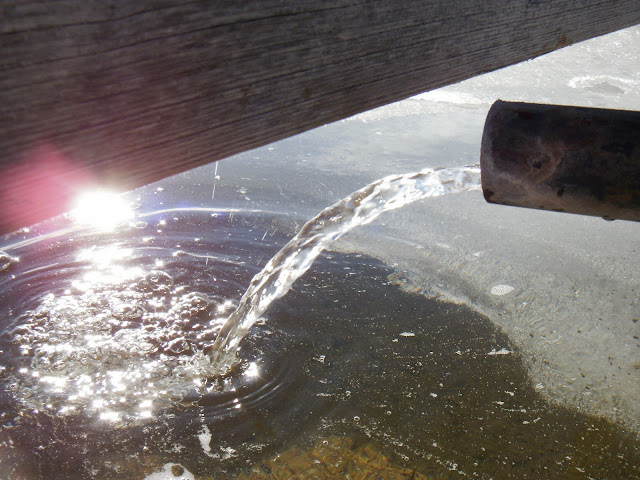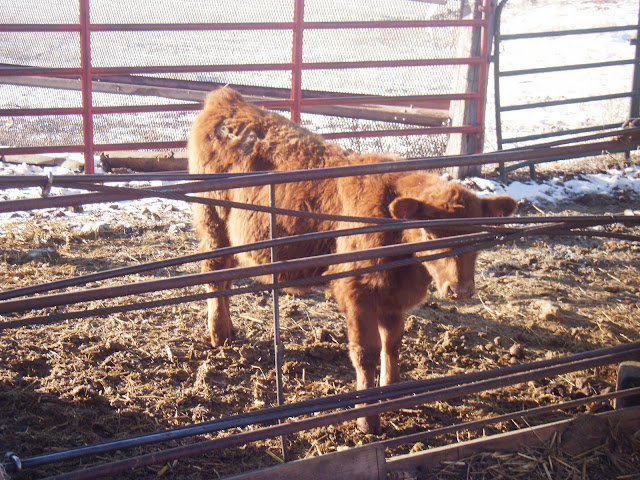At some level, I can't help myself. I'm in love with the English language, with lyrical prose, with attempting to employ those things to share the experiences I love. Perhaps that indicates only that I'm in love with myself; with my thoughts and my deeds and my words and my world view.
Stephen King (and about a zillion other successful writers) says that one should write for (to?) the ideal reader; an imaginary construct representing not only those you are writing to, but those you are trying to give the experience of joyful reading.
My ideal reader is a fuzzy, ill-defined construct at best. It might even secretly and subconsciously be me. Ah, nothing like pondering the unknowable. But I digress.
I’ve written about this subject before.
Five years and some months ago, as weather autumn ended on
an especially lovely October Saturday and winter arrived in the night with cold
and snow, I shared the experience in a column in a different newspaper. The
opening line of that column was, “Every season has a last, best day.”
 |
| Light and shadow cast by High Plains December sunlight |
Winter weather usually arrives here before calendar fall
expires. In itself, that's little different than anywhere else in our hemisphere, at least north of the tropics. The farther north you go, the
earlier winter arrives and the longer it lingers into calendar spring. Our
planet’s weather doesn’t seem to care much about our calendars, though in a a lovely and
ironic twist, we rely utterly on nature – the celestial mechanics of Earth’s
axial tilt and it’s orbit around the sun; the moon’s orbit around
our planet – to write our calendars.
On Sunday, with the shortest day of the year rapidly
approaching (winter solstice will occur at 10:30 p.m. MST tomorrow, Dec. 21), one would
normally expect the weather conditions to be cold and windy, with perhaps even
a lot of snow on the ground.
But Sunday was absolutely gorgeous. It was warm, the sky was
deeply blue with only scant, fleecy cloud cover, the ground was mostly clear of
snow, and a light southerly breeze was wafting gently across the prairie. It
was definitely time for a hike. Having been laid low with a month-long
cold and an injury to my yet-to-be repaired starboard calcaneal Achilles
insertion, I’d been gimping and wheezing around for far too long.
I prepared carefully. Hiking the prairie in December is
potentially dangerous, particularly in and around the rock-strewn gullies I
love to explore. Snow and ice lurk in the permanent winter shadows, and where the season’s slanting
sunshine does fall, thin mud layers form atop frozen soil. A wrong step on
treacherous ground can lead to a slip, fall and tumble – and potentially – a
mobility reducing injury. An injured, immobile hiker will be in big trouble
when the early sunset allows the true, cold character of the December prairie
to reassert it’s iron grip.
For a prairie hiker, one who relies on his feet to get him
in and get him out, boots and socks are of penultimate importance. I wear Ingenious socks and Danner boots. They’re top of the line and
priced accordingly but, oh my, are they ever worth the cost.
I double-checked my rucksack to ensure the appropriate
survival gear was there; first aid kit, fire starter, hard candy, spare water, a hand-cranked emergency cell phone charger. I added a sealed bag of dry
clothing, a trio of insulating poncho liners, and extra gloves. The additions
boosted the weight of my ruck to 51 lbs, a not inconsiderable load for a 50
year-old hiker.
I grabbed my rifle, pistol, GPS hand held and camera and headed
out.
Why carry the shootin’ irons? There are a number of reasons.
First and foremost, while the Second Amendment to the Constitution of the United
States guarantees me the right to keep and bear arms, it does not spell out
the ethical responsibility of owning and operating a lethal device. That's on me. I take it seriously. The skill set required to carry and use firearms,
including the rigor of a maintaining a responsible mindset, requires practice.
Every thing I do on a hike is predicated on weapon safety and discipline. Another reason is that the
rifle and pistol and their ammunition, like the bulging rucksack, increase the
load I carry, and that increases the exercise quality of my hike. I could carry
rocks and a crowbar for exercise enhancement, but I’d have to give up the
discipline of responsibility. Bad trade. Finally, I might have to employ my weapons in
their lethal capacity. The chance of such a thing happening is tiny, but a
weapon locked up miles away is useless should such a situation arise.
Shouldering my rucksack and taking up my rifle, I set out.
Muscles and joints complained at the unaccustomed load and my foot-eye
coordination was terrible. I kept stepping on small rocks and other
foot-twisting features of the prairie landscape. My heart began to hammer and
my ragged breath was that of a fat old man struggling up a short flight of stairs. I was anything but agile, nor were my efforts worthy of the beauty of the day or the joy of the task.
But slowly, oh so slowly, my mind and body responded to the
challenge. After the first mile my tread became sure and steady, as my feet coordinated with my peripheral vision. My heart rate stayed up but my breathing became even and smooth. The cool air flowing in and out was, as always, a wonderful
sensation. The slanting rays of December sunshine were warm and comforting and
the sweat of exercise flowed freely. I began to revel in every moment. In my world, this was living.
 |
| High Plains December sunlight has a nearly Mediterranean quality |
As I hiked and breathed and poured with sweat, the peaceful beauty I’d
been unconsciously craving began to steal gently into my heart. The frown of human concerns vanished
from my face, replaced by a giddy, happy grin. An intense joy bubbled up from
deep inside. I knew with certainty how indescribably blessed I was to be there, to bear witness to the
natural beauty surrounding me.
I thought about the lines I wrote five years ago. Was it indeed the
last best day of the season? Who knows? Who cares? It was or it wasn't. Naming
the day isn’t important, and neither is predicting the future. I was there to
witness the moment, to sop up every bit of the wonder I could hold. Being part of the
here and now is far more significant, far more fulfilling than self-absorbed
speculation. Being in the moment, unbound by yesterday or tomorrow, is potent
medicine.
And it’s amazing medicine. I walked an uneven prairie at age
50, gimpy with a painful injury but alive and kicking nonetheless. The pain was
distracting but vital, a component of experience and a tool to remind me that
I’m mortal and limited. I won’t always be here, but I was still there on Sunday. I breathed
deeply and easily, my heart sent blood coursing through my veins, I bore the
pain. I was far, far from my mortal limits, the pain a gift, and very small
compared to the pain endured by others.
I stopped and slowly turned around, drinking in a complete prairie
horizon and soaking up the soft autumn light. Peace. It may have been December, with the discomfort of cold winds on the near-future weather menu,
but those things were not there in that moment. Re-centered, I could go in beauty. It was enough.
Perhaps it was everything.
I climbed to the top of a steep hill and took in the view. To
the north and south, wind turbine blades slowly rotated far away, on the edge of
the world. I dropped my load and sat, leaning back against my rucksack, rifle
across my knees. The breeze was cooling, evaporating moisture from my
sweat-sodden clothing, causing the beginnings of a shiver. A muted growling of high bypass turbofans tumbled down from
the sky. The contrails were far overhead, stark white lines across deep, towering blue.
As evening came on and the air quickly cooled, I watched
clouds begin to creep in from the west. The bright, white sun went first
orange, then red as it neared the horizon, painting the southwest land and sky
with glowing sunset colors.
As the cold crept in it became time to go. I donned a sweatshirt
and light gloves and took up my ruck and rifle. I’d come four miles and the
same distance would return me to my parked pickup. As I set off, I realized the
pain and swelling had increased in my right foot. Perhaps I’d overdone it a
bit, but I doubt I’d caused any additional injury. As I moved and stretched
muscles and joints and regained my hiking rhythm the pain receded to a dull ache.
After a time I returned to my starting place and the GPS confirmed the distance
traveled at just over eight miles, with a cumulative elevation change of nearly
6,000 feet over that distance. Who says Nebraska is flat?
As I drove away I murmured a prayer of thanks for the day and
the experience. Without a doubt, I am profoundly blessed.
Monday morning the world had changed. It was cold and damp
with fog and freezing rain in the air and ice on the ground. The horizon was
close and tight and gone were the long vistas of yesterday. I shivered in the
freezing damp as I fed calves and chopped ice. A light snow began to fall, and
snowflakes gently dotted my face with gossamer kisses. In the still, bovine-tinged
air, the crunch of chewing corn came clearly across the feedlot. Light snow
began to coat the backs of the calves as they stood lined up at their
breakfast table.
The prairie I hiked Sunday was hidden from view now, hushed
and hunkered down, waiting. Winter is coming, bringing ice and snow and bitter
cold. But right there, right then, the day was sweet.






















